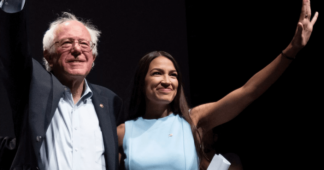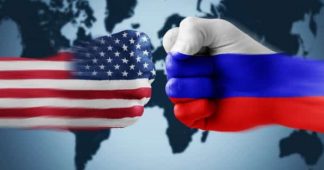Globalization, which now confronts us as a locked-in inevitability, looked quite different in the first half of the 20th century. Then, in the face of the horrors of two world wars and the breakdowns in free trade during the Great Depression, a global capitalism appeared an impossibility. It fell to the American state, backed by the dynamism of American industry and finance, to create and spread a workable, capitalist world order. At the end of WW II, about one-third of the globe stood outside of capitalism or, in the case of a number of liberation movements, were looking to exit it. By the end of the 20th century, the list of countries standing outside capitalism was limited to Cuba and North Korea.
Against that capitalist success, the country that had orchestrated it is today mired in morbid social and democratic decay. America is today a morass of dysfunctional government and festering, polarized popular frustrations, raising the claim made by many on the left that the American-led empire is on its last legs.
Are we really living though the imminent decline of the American Empire? The first section foregrounds this contention by elaborating on the nature of the postwar world order and the relationship between domestic social contradictions and the persistence of US global leadership. The next two sections address, respectively, the continuing economic foundations of American leadership even as it noticeably stumbles and the alleged Chinese challenge to American dominance. The concluding section turns to a few political implications of the argument made here.
I: Postwar World Order
Global capitalism did not flow mechanically from the ‘logic’ of capitalism; it was a contingent outcome that had to be made. The American state was at the core of this making, and its alleged decline now stands at the heart of its unmaking.
Marx and Engels bear some of the blame for seeing globalization as built into the genes of capitalism. When capitalism was still in its infancy, they famously pointed to capital’s structural thrust to “nestle everywhere, settle everywhere, establish connections everywhere.” Prescient as this was, it left out a most crucial factor: the role of states and the social forces influencing them. Bringing states into the analysis makes expectations of the smooth functioning of global capitalism problematic, since it opens the door to the politicization of competition for markets and profits. With each state partial to their own capitalists and the nationalist particularism of its workforce, conflicts were endemic to the globalization of capitalism. Add the fact of uneven economic development – some states emerge stronger, others weaker – then prospect of conflicts and rivalry are ever-present.
As WW II moved to a close, and the very possibility of a stable global capitalism seemed a chimera, the American state – drawing lessons from capitalism’s catastrophic recent history and in the context of its unique position emerging from the war – laid the foundation for a new kind of imperialism. Territorial empires were, in general, to be done away with and replaced with a universal empire of formally sovereign states open to capital and trade from all countries and ever more mutually interdependent. The rule of law, essentially directed to preserving and extending private property rights and the rule of liberalized markets, was to govern the allocation of labour, resources, and capital.
Each state was to be responsible for creating the conditions for global accumulation within their own territories, including equal treatment of foreign capital and domestic capital. It fell to the American state – with its special economic, financial, administrative, and military capacities – to act as the proxy global state in the making and superintending of this totality. Military intervention did not disappear but was now distinct from the past in that its role was not primarily to plunder and exploit through force. Rather, and much like the ‘voluntary’ modal functioning of capitalism domestically, the military’s role was to preserve/expand the conditions for a commodified, rule-based world to go about its business.
In this world of sovereign states, one state – the American state – was more sovereign than others. That special autonomy was an essential requirement of being able to act in the interests of the whole. Other states came to assent to, though not without periodic tensions, the functional importance of accepting the reproduction of the leadership role of the US as the ‘indispensable state’. Finance, though spreading its wings globally, remained rooted in the US. This provided finance with the privileges that flowed from being anchored in the US dollar, the regulatory framework provided by the Federal Reserve and the Treasury, the elemental assistance of the Fed during financial crisis (the Fed coming over time to effectively act as the world’s central bank). For capital as a whole, the supportive role of the American state in paving the way to entry abroad and protecting capitalism everywhere from populist threats, was critical.
Though this world order included international institutions that facilitated the expansion and deepening of global capitalism and managed disputes between states, the foundation of their authority came from individual states. The legitimation of the world order was likewise not carried out through external institutions but by way of the responsibility of each state carrying the message that participating in global capitalism and accepting its discipline held out a future of national economic success.
That these promises of shared prosperity generally faded for working classes was inseparable from the competitive pressures placed on states to prioritize capital accumulation over social needs. In the US, this took on added tensions because while the benefits of empire benefited American capital, the fiscal and trade burdens of superintending capitalism fell largely on the working class (e.g., the diversion of state expenditures from social programs to the military and the movement of jobs abroad). This posed the arresting question, exploited by Trump: if the US was the dominant power in the world, why then weren’t its workers getting a larger share of the benefits?
To the extent that the profound malaise in American society was taken as evidence of an imperial malaise, much of the left cheered on its apparent failures. After all, if American power is a repressive force, its weakening must be a good thing. Yet in the absence of an effective left, highlighting declinism is at least as likely to lead to a lowering of expectations in the US as to a more progressive or radical reaction. It can, for example, lead to support for strengthening US corporations to make them more competitive, with the corollary that workers must accept restraint.
To many workers, coping with survival and no clear alternatives or counterforce, the return to a recent past that they formerly criticized seemed, in the face of the new turmoil in their lives, not all that bad and even acceptable. Or, as with Trumpism, existing frustrations could be captured by the far right even if their nationalist dictums are facile in terms of solving their problems. (For all of Trump’s promises to bring jobs back by raising tariffs on China, the ultimate result of his performative actions was that China further opened its markets to US financial and high-tech firms while manufacturing jobs in the US mid-west continued to languish.)
Furthermore – and again affected by the absence of a strong left – the American empire does not rest on meeting social needs but on its material capacity to further the profitable expansion of capital. Unless the social letdowns lead to a challenge to the economic and political structures of capitalism and impose limits on their functioning, then capitalism – even a very ugly capitalism – can lurch on. It is to that material capacity of American capital and the American state, key dimensions around which a decisive decline of the American empire revolve, that we now turn.
II: American Leadership
Evaluating America’s material base is ultimately an empirical question. However, addressing it in narrow economic terms won’t get us very far. Economic ‘facts’ rarely stand alone. Similarly, pointing to repeated incidents of crises as harbingers of a deeper imperial collapse carries its own ambiguities. The issue isn’t whether disruptions occur – the making of a global capitalism is a complex and uneven historical process with inevitable potholes – but rather whether, once a ‘sea of troubles’ does surface, the American state has the capacity to respond in ways that contain and end them – a capacity it has demonstrated in recent history.
The US has run trade deficits every year since 1976. This overlapped with the loss of significant sections of America’s manufacturing base. Surely this suggests accumulating imperial weaknesses? Not necessarily. A particular indicator – such as recurring trade deficits – can have different implications for states occupying different positions within the hierarchical whole.
For all states other than the American one, repeated trade deficits bring pressures for painful countermeasures. However, for an extraordinary state like the American, the pressures are subdued. It can, comfortably and over long stretches, import more than it exports and finance the gap from the funds that overseas investors eagerly place in US financial markets. So rather than the US trade deficits being indicators of economic failure, they are in fact indicators of American strength. Perennial American trade deficits highlight America’s privileged access to accessing global labour power and global savings.
There is no denying that the deficits came with the devastation of significant sections of US manufacturing. This is somewhat qualified if we measure such trends in the (capitalist) calculus of dollar values, rather than jobs. US industrial production has increased 64% over the past 25 years, even allowing for inflation (the growth is slower in the most recent years but, nevertheless, persists). And nominal profits among non-financial corporations, which crashed during the 2008-2009 financial crisis, recovered, and by 2011 stood 86% above their pre-crisis peak in 2006.
Far more significant, however, is that even as great numbers of American plants closed, expansions and new industries sprung up in other US domestic sectors and regions. This qualitative restructuring of American business was biased toward goods and services that stood at the strategic apex of the global economic pyramid: high-tech goods and platforms (Apple, Google, Big Pharma); massive distribution networks (Amazon, Walmart); and business services that served capital across the globe (engineering, legal, accounting, advertising, consulting, and, of course, finance). For those who lost their jobs this offered little or no compensation; for the reproduction of US economic power, it was pivotal.
A decisive factor in assessing American decline has been the flexibility and creativity of the American state in responding to repeated crises. Consider the crisis of the 1970s. The large US investments overseas, enormous military expenditures abroad, and growing import deficits sent far more US dollars overseas than were returned. This created a glut of dollars abroad that led to the collapse of the post-war Bretton Woods arrangements. The outcome of this crisis was, however, increased international dependence on the US dollar, leaving the US with even greater maneuverability in its international activity.
By the mid-1970s, the US faced stagflation: inflation and unemployment. After a decade long period of social angst and failed solutions, the American state revamped its mode of accumulation: finance was liberalized, globalization accelerated, and the labour movement largely crushed. The restructuring that ensued strengthened the dollar, restored profits, and the US regained its global strut.
The Great Financial Crisis of 2008-9 was the deepest and most threatening crisis since the Great Depression. Originating in the US itself, it seemed to discredit American ‘cowboy finance’, signal the end of neoliberalism, and even threaten the survival of capitalism. What saved the American and global financial system was the unprecedented intervention of the American state with the Federal Reserve essentially acting as the world’s central bank. The US returned to business as usual, and foreign savings accelerated their shift to the state-backed safety of US financial markets.
The growing weight of finance in the US economy has itself been widely interpreted as a convincing indicator of industrial decline. But American finance has been integral to, rather than a diversion from, economic advance (grasping this helps explain industrial capital’s acquiescence to, if not active support for, ‘financialization’). Finance facilitates accelerated globalization by providing risk insurance on fluctuating exchange rates. Its fluidity fast-tracks the reallocation of capital to the most promising sectors and to new ventures. It reinforces more ‘rational’ measures for internal corporate investment decisions. And for all the instabilities finance brings, it also provides macro support for the economy through debt. Through all this, finance more rigorously disciplines and integrates working classes to the priorities of capital accumulation.
III: Chinese Challenge
China – with its population of 1.3 billion, first-place ranking in manufacturing production and exports alongside an impressively developing technological capacity and its rise as a military power – stands as the only credible alternative to American dominance.
For at least a decade now, China has warned of reducing its dependence on the American dollar, this being read by many as signaling a pivotal undermining of the dollar’s global influence. Yet, in the years after the 2008-9 financial crisis, it actually doubled its purchases of US Treasuries and has run neck-and-neck with Japan as the largest such buyer (the UK ranks third, about 40% below China). As with Japan, China’s holdings of US dollars are partly to keep its currency lower and its exports, therefore, more competitive, and partly out of caution to limit US protectionist reactions.
Nor has China been able to reverse the make-up of the foreign exchange reserves held by central banks. Near 60% of such holdings are in US dollars; the Euro ranks second at slightly over 20%, with the Pound and Yen following at roughly 6% each. The Renminbi trails at 3% (only slightly above the Canadian dollar). Note that the increased role of the Euro, far ahead of the RMB, occurred with little or no threat to the US dollar and even helped stabilize the role of the dollar by acting as a complementary currency. (See John Grahl’s convincing emphasis on the extent to which the Euro is anchored to and dependent on the dollar and the US Fed.)
As for the use of the dollar in international transactions (official currency reserves, foreign exchange transactions, foreign currency debt instruments, cross-border deposits, and cross-border loans), an index constructed by the Federal Reserve demonstrates the unambiguous dominance of the US dollar and the stability of this dominance. Though the Renminbi has grown significantly in percentage terms, in global terms it remains a very secondary player, far below not only the Euro but even the Pound and Yen.
None of this negates the significance of China’s prominence in influencing modulations in the trajectory of global capitalism and adding tensions to global geopolitics. The point, rather, is that China does not have the capacity – or interest – to fundamentally challenge the role of the American dollar and, thereby, American imperial leadership. This is not just a matter of needing time to get there, but structural.
To emerge as a leading global currency, a state’s financial markets must not only be deep, liquid, and sophisticated but also sufficiently liberalized to overcome fear of arbitrary state interventions and threats to private property rights. This is something the Chinese Communist Party (CCP) will not contemplate; maintaining central control over finance is a foundation of its control over the economy and its consequent legitimation.
More fundamentally, those whose analysis is driven by the mantra of inter-imperial rivalry tend to mistakenly assume that China’s strategic interest and ambitions lie in replacing the US. China’s primary concern, however, remains ‘primitive accumulation’ and economic modernization – the fundamentals of its transition from a peasant society and to regime legitimation. Its chosen means have been through its integration, to an extent with no historic precedent, into a global capitalism overseen by the US.
Within that framework, China seeks acknowledgement and respect as a major global player with a rightful claim to raising its status within the hierarchy of capitalist states. The overthrow of America’s role and taking up the substantive burdens of empire are not, at least for the near future, its strategic goal. In this spirit, China has not challenged America’s imperial authority but rather called on the US to act as a ‘responsible’ imperial power rather one that, taking advantage of its special role, arbitrarily flouts rules as it sees fit (as Trump especially posed but Democrats periodically also do).
Here too, it is not just the contradictions of the American Empire that matter but also those of China. China’s recent successes cannot be cavalierly projected into the future. Its growth will be restrained by environmental limits; regional and intra-class divisions have emerged in the debates around outward vs inward-oriented development; and China’s expansions abroad are not always received with gratitude.
Most important, however, are the trends in class formation that are obscured by the official ideology of the focus on the productive base as an essential condition for preparing for socialism. China’s model of development has created a powerful capitalist class with international links and some autonomy from the CCP and the state. Constant threats to contain its oligarchs, redistribute their wealth, and end their corruption so far remain largely performative.
At the same time, China’s extreme dependence on global competition has enforced domestic standards and pressures that undermine working conditions and social priorities. Though living standards have dramatically increased as far as individual consumption is concerned, frustrations over housing, health care and other social benefits, and democratic reform remain serious popular sore points. Of greater significance, and in contrast to the development of a capitalist class, moves to nurture an independent and coherent working class are regularly suppressed.
IV: Confronting Capital and Capitalism
Among the complex issues Russia’s invasion of Ukraine raises for the global left, two are most significant for purposes of this article. Are we witnessing a revival of inter-imperial rivalry? And what does the war indicate about the decline of American dominance?
Russia’s invasion of a formally sovereign country was an imperialist act. But while it challenged the extent of American unipolar dominance, it did not pose a challenge to the fact of American empire. Russia has a capacity to act independent of the American empire but nowhere near the capacity to contemplate the traditional meaning of inter-imperial rivalry: the goal of replacing the existing imperial power. Nor, yet, is China – whose development continues to depend on its integration into US-led global capitalism – ready to join Russia in a power bloc to take on such a project.
As for American decline, though Russia’s invasion pointed to the limits of American power, it also demonstrated the hold the US continues to have over its nervous yet so-far obedient allies. It also showed the stunning range and scale of the sanctions it can mobilize to complement its military power and the unique scope of its propaganda machine.
And yet, this too includes contradictions in American power that are still playing out. These span the barriers to direct involvement with NATO ground troops, the blow-back from the sanctions that are harming the ‘West’ as much as Russia, and the reluctance of so much of the global south to endorse the US role in Ukraine. The latter is a reaction – reflecting hard-learned historical lessons – to the cynicism of the US now carrying the mantle of a defender of state sovereignty. It is reinforced by the well-founded fear in much of the developing world that should they themselves express their own sovereignty and ‘get out of line’, they too will face the demonstrated power and range of US sanctions.
The main point here for the left is that we must not put any weight on inter-imperial rivalry or declinism to do the heavy lifting for us. The divisions and conflicts among capitalist states (which includes Russia) are not where we should expect to find new political spaces for the left. As emphasized earlier, absent a strong domestic left, if intense inter-imperial rivalry were to break out, it would not necessarily, or even be likely to, work to our advantage; it could just as possibly bring chaos and add to the dangers of nationalism and nuclear war. The same goes for negative trends in American economic strength. This may generate counter-responses to correct such a trajectory through intensified attacks on the working class.
For now, Mark Twain’s response in discovering his obituary in a newspaper can be echoed here: pronouncements of the death of the American Empire have been ‘greatly exaggerated’. As long as the American working-class accepts its fate and leaves the American state with the time and political space to cope with its problems, the American Empire can stumble and list but will carry on.
We cannot challenge the imperial trajectory on military expenditures, free trade, capital movements, and the subservience to corporate priorities unless we also confront the practical question of de-coupling from global capitalism and its discipline while, for the time being, still living within capitalism.
This points to a greater emphasis on inward development, democratizing finance and the allocation of the social surplus, and expanding inroads into public ownership and democratic planning – that is, carving out spaces within capitalism which inherently defy capitalist logic, such as systematically addressing conversion along environmental lines, expanding public services relatively to private ones, democratizing the state, and spreading unionization (alongside also building unions of a renewed kind).
There is a sobering lesson here from the conclusions that capitalist elites came to in the crisis of the 1970s and which still define the present moment: muddling through is not good enough. For capital and the state, that earlier crisis had hardened an understanding that it had become necessary to drastically deepen rather than ‘regulate’ capitalism.
In contrast, the labour movement never came to grips with this reality of polarized options. That failure now defines the labour movement’s unending crisis. Capital has long since stopped offering any middle ground and capitalist structures – locked into competitive survival – cannot offer it. Our only genuine option is to build the social forces that can deliver radical change.
It is tempting to battle capitalist internationalization by countering it with a working-class internationalism. Specific acts of international solidarity are, of course, possible, and an internationalist sensibility is paramount. But we cannot act substantively on the international stage without being strong at home.
If we cannot build genuine solidarity across the class at home, it is an illusion to think we can skip this step and build it across borders. As the Communist Manifesto so clearly put it, “Though not in substance, yet in form, the struggle of the proletariat with the bourgeoisie is at first a national struggle. The proletariat of each country must, of course, first of all settle matters with its own bourgeoisie.” •
We remind our readers that publication of articles on our site does not mean that we agree with what is written. Our policy is to publish anything which we consider of interest, so as to assist our readers in forming their opinions. Sometimes we even publish articles with which we totally disagree, since we believe it is important for our readers to be informed on as wide a spectrum of views as possible.











